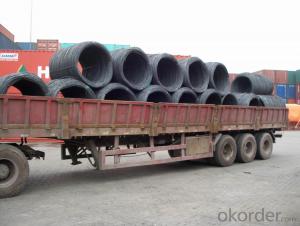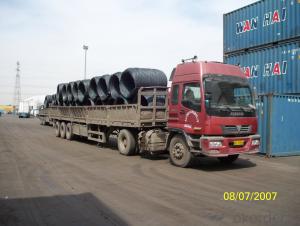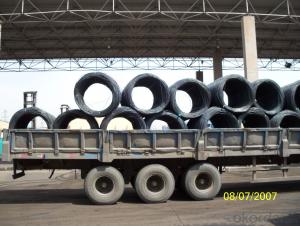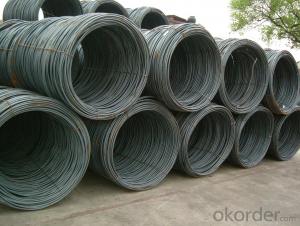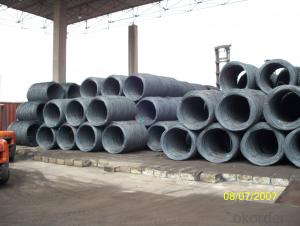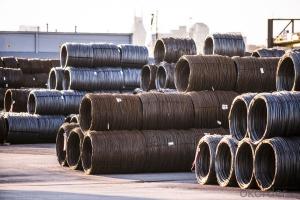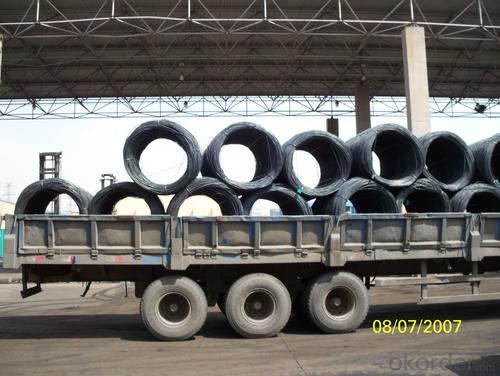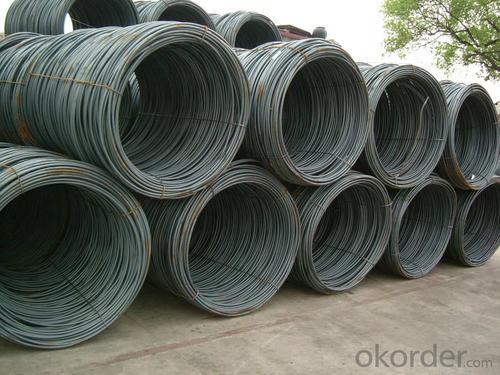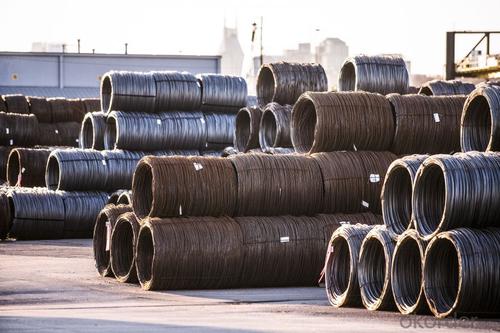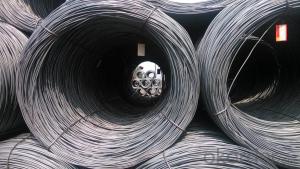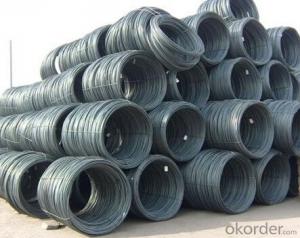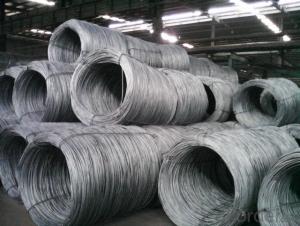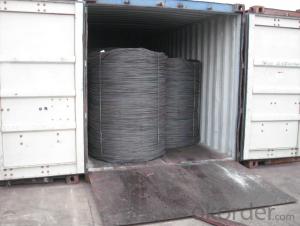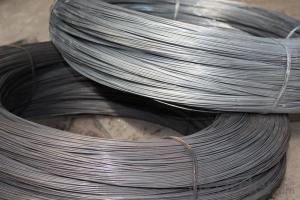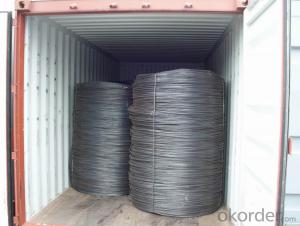SAE1006Cr Carbon Steel Wire Rod 8.5mm for Welding
- Loading Port:
- Shanghai
- Payment Terms:
- TT OR LC
- Min Order Qty:
- 100 m.t
- Supply Capability:
- 30000 m.t/month
OKorder Service Pledge
OKorder Financial Service
You Might Also Like
Specification
Description of SAE1006Cr Carbon Steel Wire Rod 8.5mm for Welding:
OKorder is offering Color Coated Steel Coil Prepainted Steel Coil at great prices with worldwide shipping. Our supplier is a world-class manufacturer of steel, with our products utilized the world over. OKorder annually supplies products to European, North American and Asian markets. We provide quotations within 24 hours of receiving an inquiry and guarantee competitive prices.
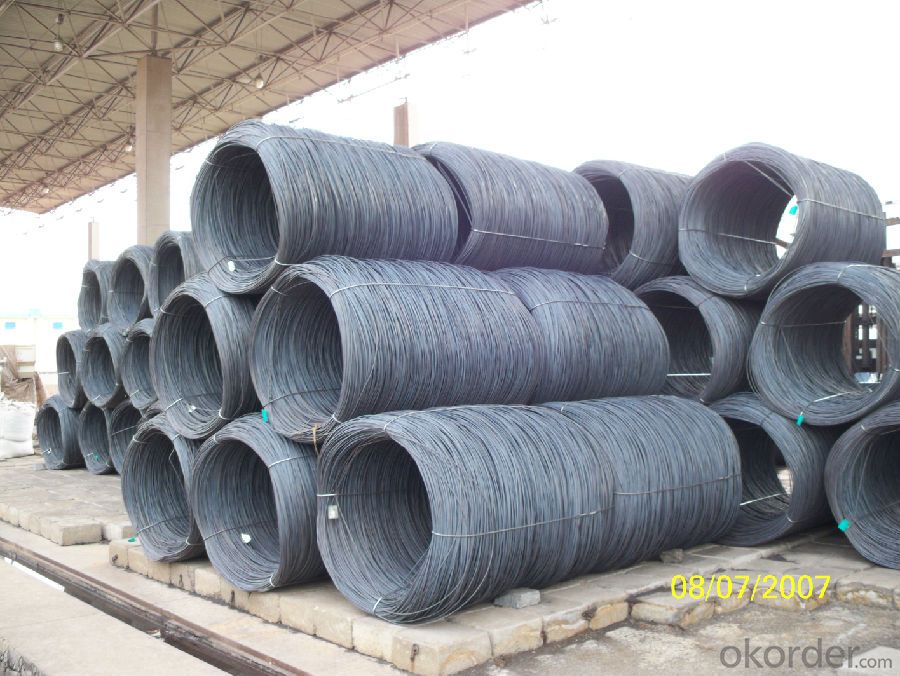
Applications of SAE1006Cr Carbon Steel Wire Rod 8.5mm for Welding:
Color Coated Steel Coil Prepainted Steel Coil are ideal for structural applications and are widely used in the construction of buildings and bridges, and the manufacturing, petrochemical, and transportation industries.
Main Product Features of SAE1006Cr Carbon Steel Wire Rod 8.5mm for Welding:
· Premium quality
· Prompt delivery & seaworthy packing (30 days after receiving deposit)
· Corrosion resistance
· Can be recycled and reused
· Mill test certification
· Professional Service
· Competitive pricing
Specifications of SAE1006Cr Carbon Steel Wire Rod 8.5mm for Welding:
PPGI:
1, Introduction: Color coated steel coils(sheets), i. E. PPGI, also called prepainted steel coils(sheets), are made of galvanized steel coils(sheets) with polymer coatings as surface. It's a new enclosure material and building board with characteristics of light-weighted, heat preserved&insulated, easily installed with bright colors.
2, Production Process: Pretreatment(Degreasing)_Drying_Chromating_Paint Basic Oil_Cooling_Drying_Color Coating_Cooling_Film-covering_Rolling Up
3, Characteristics:
Good at corrosion resistence. Besides zinc coating of the basic plate of galvanized steel sheet, the color coating as the surface has double lifetime to ensure better anticorrosion effect.
With excellent cold bending molded manufacturablity, PPGI products can be processed or directly used as final product. As being light-weighted and conveniently transported, they're widly used to replace wood to save energy.
4.There're thousands of colors can be chosen as per different application. Any color plays well in decoration.
No pollution with high recycling rate, PPGI coils and sheets are strongly recommended as enviroment-friendly products by the government.
5, eye bands and 4 circumferential bands in steel, galvanized metal fluted rings on inner and outer edges, galvanized.
| commodity | SAE1006Cr Carbon Steel Wire Rod 8.5mm for Welding |
| Techinical Standard: | JIS G3302-1998, EN10142/10137, ASTM A755 |
| grade | Q195,Q215,Q235,SAE1006,SAE1008 SAE1006Cr |
| Types: | Mesh welding |
| Base metal | galvanized, galvalume, cold rolled steel |
| Thickness | 0.14-1.0mm(0.16-0.8mm is the most advantage thickness) |
| Width | 610/724/820/914/1000/1200/1219/1220/1250mm |
| Type of coating: | PE, SMP, PVDF |
| Zinc coating | Z60-150g/m2 or AZ40-100g/m2 |
| Top painting: | 5 mic. Primer + 15 mc. R. M. P. |
| Back painting: | 5-7 mic. EP |
| Color: | According to RAL standard |
| ID coil | 508mm610mm |
| Coil weight: | 2--3MT |
| Package: | Properly packed for ocean freight exportation in 20'containers |
| Application: | Industrial panels, roofing and siding for painting/automobile |
| Price terms | FOB, CFR, CIF |
| Payment terms | 20%TT in advance+80% TT or irrevocable 80%L/C at sight |
| delivery time | 25 days after recepit of 20% TT |
| Remarks | Insurance is all risks |
| MTC 3.1 will be handed on with shipping documents | |
| We accept SGS certificatation test |
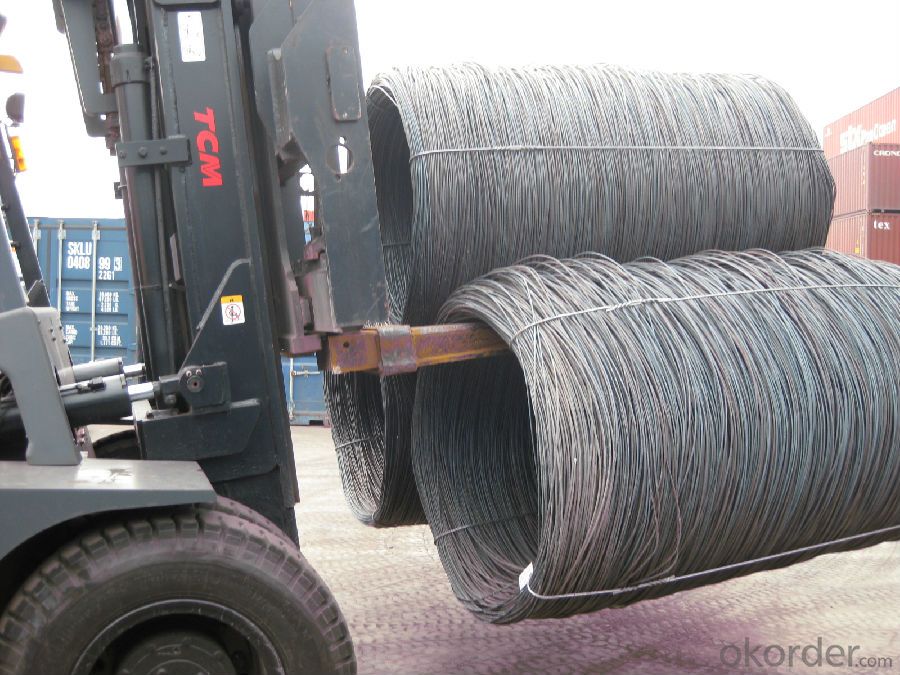
FAQ of SAE1006Cr Carbon Steel Wire Rod 8.5mm for Welding:
Q1: Why buy Materials & Equipment from OKorder.com?
A1: All products offered byOKorder.com are carefully selected from China's most reliable manufacturing enterprises. Through its ISO certifications, OKorder.com adheres to the highest standards and a commitment to supply chain safety and customer satisfaction.
Q2: How do we guarantee the quality of our products?
A2: We have established an advanced quality management system which conducts strict quality tests at every step, from raw materials to the final product. At the same time, we provide extensive follow-up service assurances as required.
Q3: How soon can we receive the product after purchase?
A3: Within three days of placing an order, we will begin production. The specific shipping date is dependent upon international and government factors, but is typically 7 to 10 workdays.
Q4: What makes stainless steel stainless?
A4: Stainless steel must contain at least 10.5 % chromium. It is this element that reacts with the oxygen in the air to form a complex chrome-oxide surface layer that is invisible but strong enough to prevent further oxygen from "staining" (rusting) the surface. Higher levels of chromium and the addition of other alloying elements such as nickel and molybdenum enhance this surface layer and improve the corrosion resistance of the stainless material.
Q5: Can stainless steel rust?
A5: Stainless does not "rust" as you think of regular steel rusting with a red oxide on the surface that flakes off. If you see red rust it is probably due to some iron particles that have contaminated the surface of the stainless steel and it is these iron particles that are rusting. Look at the source of the rusting and see if you can remove it from the surface.
- Q: What are the safety standards for steel wire rod used in construction?
- The safety standards for steel wire rod used in construction vary depending on the specific application and local regulations. However, some general safety standards include ensuring the wire rod meets the required strength and quality specifications, proper storage and handling to prevent damage or injury, regular inspection for defects or signs of wear, and adherence to proper installation and usage guidelines. Additionally, safety standards may also dictate the use of personal protective equipment and training for workers involved in handling or working with steel wire rod in construction projects. It is essential to consult relevant industry guidelines and local regulations to ensure compliance with specific safety standards.
- Q: What are the main factors affecting the market distribution of steel wire rod?
- The main factors affecting the market distribution of steel wire rod include global demand and supply dynamics, economic growth and industrial production levels, trade policies and tariffs, technological advancements, competitive pricing, availability and cost of raw materials, transportation and logistics infrastructure, and government regulations on quality and standards. Additionally, factors such as fluctuating exchange rates, environmental concerns, and changing customer preferences also play a role in shaping the market distribution of steel wire rod.
- Q: What are the common maintenance practices for steel wire rod?
- Some common maintenance practices for steel wire rod include regular cleaning to remove dirt and debris, inspecting for any signs of corrosion or damage, lubricating moving parts to prevent friction, and storing in a dry and climate-controlled environment to prevent moisture and rust. Additionally, proper handling and storage techniques should be followed to ensure the longevity and quality of the steel wire rod.
- Q: What are the common production processes for protactinium-coated steel wire rod?
- The common production processes for protactinium-coated steel wire rod typically involve several steps. First, the steel wire rod is thoroughly cleaned and prepared to ensure its surface is free of any contaminants. Then, a layer of protactinium is applied to the steel wire rod using a specialized coating technique such as electroplating or chemical vapor deposition. This process ensures a uniform and durable coating of protactinium on the wire rod. Finally, the coated wire rod is carefully inspected and tested for quality control before it can be used in various applications.
- Q: What are the different types of steel wire rod testing equipment?
- There are several types of steel wire rod testing equipment that are commonly used in the industry. These include tension testing machines, hardness testers, surface defect detection devices, ultrasonic flaw detectors, and spectroscopes for chemical composition analysis. Each of these tools serves a specific purpose in ensuring the quality and performance of steel wire rods.
- Q: What are the different rolling processes used for steel wire rod production?
- Steel wire rod production utilizes various rolling processes, each with its own merits and uses. 1. The most prevalent and widely employed method is hot rolling. This entails heating steel billets to high temperatures and passing them through rolling mills. Hot rolling yields a more malleable and flexible wire rod, making it suitable for applications in construction, automotive, and manufacturing industries. 2. In contrast, cold rolling involves rolling the wire rod at room temperature. This process enhances the wire rod's surface finish and dimensional accuracy. Additionally, it improves the mechanical properties, enabling its use in specialized applications such as high-strength wires, springs, and electrical conductors. 3. Continuous casting and rolling combine the casting and rolling processes into a seamless operation. Molten steel is directly cast into thin slabs or billets, which are then rolled into wire rods without intermediate reheating. This integration offers advantages like enhanced efficiency, reduced energy consumption, and improved product quality. 4. Microalloying rolling incorporates small amounts of alloying elements into the steel composition to enhance its strength and other mechanical properties. This method is commonly employed in the production of high-strength wire rods for construction, infrastructure, and automotive industries. 5. Thermomechanical rolling employs a combination of hot rolling and controlled cooling to achieve specific mechanical properties. By manipulating the cooling rate, the microstructure of the wire rod can be altered, resulting in improved strength, toughness, and formability. This process is often utilized in the production of high-quality wire rods for critical applications such as suspension cables, ropes, and steel reinforcement. In conclusion, the choice of rolling process for steel wire rod production depends on factors such as desired mechanical properties, surface finish, and application requirements. Each process provides distinct advantages, enabling manufacturers to tailor wire rods to specific applications.
- Q: What are the differences between wire rod, round bar and thread steel? Respective specifications?
- Wire rods are round, like wire balls. They should be adjusted when they are used. There are usually 6.5 and 8 millimeters in diameter
- Q: How is steel wire rod used in the manufacturing of wire for automotive fuel injection systems?
- Steel wire rod plays a vital role in the production of wire for automotive fuel injection systems. This type of high-quality steel wire is essential for crafting the diverse wires and cables needed for these systems. One of the primary applications of steel wire rod in the manufacturing process is for creating fuel injector wiring harnesses. These harnesses are responsible for linking the fuel injectors to the vehicle's electronic control unit (ECU). By drawing the steel wire rod into thin and precise wires, they can be braided or twisted together to form the necessary harnesses. The selection of steel wire rod for this process is based on its exceptional strength, durability, and electrical conductivity. It must be capable of withstanding the challenging conditions under the vehicle's hood, including high temperatures, vibrations, and exposure to chemicals. Moreover, steel wire rod is also utilized in the production of other wires and cables within the fuel injection system. This includes sensor cables, which transmit data from various sensors to the ECU, as well as power cables, which supply electrical power to the fuel injectors. Overall, the significance of steel wire rod cannot be overstated in the manufacturing of wire for automotive fuel injection systems. Its strength, durability, and electrical conductivity ensure the proper operation and durability of these systems, ultimately enhancing the performance and efficiency of the vehicle.
- Q: How is steel wire rod used in the production of tire cords?
- Steel wire rod is an essential component in the production of tire cords. Tire cords are reinforcements that are embedded within the rubber of tires to provide strength and support. Steel wire rod is first processed through a series of steps to transform it into the desired form for tire cord production. The steel wire rod is initially hot rolled to reduce its diameter and increase its length. This process adds strength and flexibility to the wire rod, making it suitable for tire cord applications. After hot rolling, the wire rod is further processed through a heat treatment known as patenting. This heat treatment enhances the wire's mechanical properties, such as tensile strength and elasticity, ensuring it can withstand the demanding conditions experienced by tires. Once the steel wire rod has been appropriately processed, it is then drawn through a series of dies to achieve the desired diameter and surface finish. This drawing process further enhances the wire's strength and surface quality, ensuring it meets the stringent requirements for tire cord production. The drawn steel wire rod is then coated with a layer of brass or zinc to improve its adhesion to the rubber compound used in tire manufacturing. This coating also provides corrosion resistance, extending the lifespan of the tire cords. Finally, the coated steel wire rod is twisted into cord structures with multiple strands, forming the tire cord. These cords are then embedded into the rubber during the tire manufacturing process. The tire cords provide essential reinforcement, helping the tire withstand the internal pressure, external forces, and provide stability during vehicle movement. In summary, steel wire rod is a crucial material used in the production of tire cords. Through a series of processing steps, including hot rolling, heat treatment, drawing, and coating, the wire rod is transformed into high-strength and durable cords. These cords are then embedded within the rubber of tires to provide essential reinforcement and support, ensuring the tires can withstand the challenging conditions they encounter on the road.
- Q: What is the typical chemical composition of steel wire rod?
- Steel wire rod can have different chemical compositions depending on its grade and intended use. The main element in steel wire rod is iron, accompanied by small quantities of carbon, manganese, phosphorus, sulfur, and silicon. Carbon plays a significant role in providing strength and hardness to the material. Manganese is commonly added to enhance the steel's hardenability and strength. Phosphorus and sulfur, which are impurities, are typically minimized to avoid negative impacts on the steel's properties. Silicon is incorporated to improve deoxidation and corrosion resistance. It should be noted that the amounts of these elements can vary in different grades of steel wire rod. Additionally, other alloying elements like chromium, nickel, or molybdenum may be included to achieve specific properties required for different applications.
Send your message to us
SAE1006Cr Carbon Steel Wire Rod 8.5mm for Welding
- Loading Port:
- Shanghai
- Payment Terms:
- TT OR LC
- Min Order Qty:
- 100 m.t
- Supply Capability:
- 30000 m.t/month
OKorder Service Pledge
OKorder Financial Service
Similar products
Hot products
Hot Searches
Related keywords
